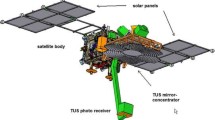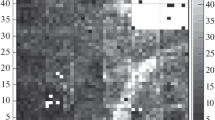Abstract
The TUS detector is the first orbital telescope designed to test techniques for measuring ultraviolet fluorescence and Cherenkov radiation of extensive air showers (EASes). The detector was launched aboard the Lomonosov satellite on April 28, 2016. A two-level event selection system (trigger) was developed and implemented in the digital electronics of the photodetector. This trigger was optimized for the search for EASes, but at the same time operated under conditions of variable atmospheric luminescence of both natural (aurora light, diffused moonlight, thunderstorm phenomena) and anthropogenic origin (city lights, flashes at airports). The frequency of the trigger also depends on that of transient atmospheric phenomena of different origin. Examples of events recorded by the TUS detector and selected welve by the EAS trigger are given.
Similar content being viewed by others
Avoid common mistakes on your manuscript.
INTRODUCTION
One of the main tasks in studying ultraviolet (UV) bursts in the nighttime atmosphere with the TUS telescope are flares caused by the particles of ultra-high energy cosmic rays (UHECRs; Е > 5 × 1019 EeV) [1] under the conditions of the telescope’s orbital flight.
The first particle with such high energy was registered in [2]. However, it was shown [3, 4] that the energy spectrum of cosmic particles can be broken up, since such particles are absorbed in intergalactic space on the photons of the Big Bang that fill the Universe. This phenomenon is called the Greisen–Zatsepin–Kuzmin (GZK) limit. The first works on this topic [2–4] were published more than 50 years ago, but the situation in identifying spectrum breakup and understanding experimental data on UHECR remains uncertain, mainly because of the exceptionally low intensity of particles with energies in the region of spectrum breakdown. The ground-based detectors with the largest areas are the Pierre Auger Observatory and Telescope Array. They have registered only 17 events with energies greater than 100 EeV [5, 6] over the past ten years, preventing any conclusions as to the nature of events and their energy spectrum.
J. Linsley and R. Benson proposed [7, 8] expanding the study of UHECRs by observing the fluorescence of the atmosphere excited by particles of extensive air showers (EASes) generated by UHECR particles, using a telescope in orbit on an Earth satellite. Such a telescope can have an atmospheric survey area two orders of magnitude greater than those at ground-based detectors and measure the direction of arrival of particles throughout the celestial sphere. The pioneering TUS telescope proposed in [9] was the first detector that allowed us to check the conditions of its operation in orbit, especially the role of noise associated with transient UV flashes in the nighttime atmosphere.
The TUS telescope is now part of the scientific equipment of the Lomonosov satellite launched from the Vostochnyi cosmodrome into an orbit with an inclination of 97.3° and with an altitude of 470–500 km.
TUS DETECTOR
The TUS detector consists of two main parts: a composite Fresnel mirror-concentrator and a photodetector in its focal plane at a distance of 1.5 m from the mirror. The latter consists of 256 pixels that have a square entrance window with sides of 15 mm, overlapping the 9° × 9° field of view of the telescope. A Hamamatsu R1463 photomultiplier with a photocathode diameter of 13 mm is used in the photodetector pixel as a UV sensor. Light from the window of the pixel is collected on the photocathode using a mirror lightguide. A UFS-1 filter is placed at the PMT photocathode. The efficiency of UV collection in the focal plane of the detector is verified in control measurements [10]. The radius of the focal spot, determined from measurements of the point spread function (PSF), grows with angle η relative to the optical axis of the telescope, and is around one pixel of the photodetector at η = 0° and two pixels at η = 4.5° (the detector’s field of view limit). The area of the mirror-concentrator is 2 m2. The charge at the PMT anode with RC = 0.6 µs is measured in the photodetector pixels every 0.8 µs using a 10‑channel ADC. One event is measured in 256 time steps of 0.8 µs. Such high resolution is used to measure fast EAS events from cosmic rays whose duration does not exceed 200 µs. Slower events (lightning, transient atmospheric phenomena, meteoroids) are measured using lower time resolution that correspond to the duration of the investigated phenomenon: 24.6 μs, 0.4 ms, and 6.6 ms with the same number of time steps (256). The detector was described in detail in [11].
ELVE-TYPE TRANSIENT EVENTS
ELVEs are the most common type of transient atmospheric phenomena. These are radiation in the atmosphere at altitudes of 80–90 km, expanding in the form of rings. ELVEs have been detected and studied using video cameras with time resolutions of less than 1 ms. It is known that ELVEs occur when ionospheric layer D is overlapped by an electromagnetic pulse (EMP) of lightning [12]. Since the duration of these phenomena is brief and the speed of a signal along a photodetector is similar to that of an EAS, the EAS trigger of the TUS detector measures effectively such events. An ordinary ELVE event, registered with the TUS telescope, is shown in Fig. 1. The map of triggered pixels shows the development of the ELVE over time from a ring radius of about 25 km at the trigger time and to a ring with a radius of more than 70 km at the end of the waveform of the triggered pixels. The lightning responsible for this ELVE was registered by a number of Vaisala lightning detectors [13] where the center of the ELVE ring was located.
It is interesting that the TUS detector also observed more complex ELVE events with more than one ring with gaps in time of 50–60 μs from the Earth orbit for the first time. Such double rings can be expected in case of a second, reflected lightning EMP from the ionosphere to the Earth and back [14]. The time interval between the rings, which corresponded to the difference between the propagation of the primary and secondary EMPs at the speed of light, indicates this. Examples of waveform and pixel maps of double ELVEs are shown in Fig. 2.
UNUSUAL TYPE OF EVENTS OBSERVED FAR FROM THUNDERSTORMS AND DETECTED BY THE TUS DETECTOR
An interesting event was selected by the EAS trigger over the Indian Ocean, 150 km from the continent of Australia (latitude, −26.95°; longitude, 112.05°). It was registered far from thunderstorms and under cloudless conditions. According to the Vaisala GLD360 lightning detector, the distance to the nearest thunderstorm was around 500 km northwest of the event. Satellite cloud data in the area of the event indicates there were no thunderstorm clouds. This event had an unusual dynamic of development (see Fig. 3). It began with an instantaneous and powerful flash with a center of brightness in the pixel (3.6) that was saturated the entire waveform. Displacement of the signal maximum over time was observed in other pixels as well (modules 2, 3, and 4). The speed of the signal on the photodetector matrix was so great we may assume that the source moved in the field of the telescope at the speed of light. The zenith angle of the track relative to the axis of the telescope was in this case 80°. The object was moving from space to the Earth. The amplitudes of the signals in the part of the event where displacement of the fluorescence maximum was observed were an order of magnitude higher than those expected from an EAS with an energy of 100 EeV. At the end of the waveforms, the signals in the pixels reached a level well above that of the noise before the event. This means that part of the UV signal continued to be emitted for more than 100 μs. These features of the considered event (a long, strong signal in the first pixel on the track’s path and strong, long-lived signals after the maximum of the light curve in the subsequent pixels) do not allow them to be considered EAS signals of ultra high energy. The nature of the unusual event (so far unique) is not clear. Events with similar characteristics are now being sought and analyzed.
CONCLUSIONS
UV events of different natures were registered using the TUS detector in the EAS mode. These phenomena cause the response of the trigger system of the detector and reduce the exposure of UHECR measurements. At the same time, these background events differ considerably from EASes in their kinematic characteristics and space–time structure. This allows offline selection and analysis. The TUS detector thus confirms the efficiency of EAS registration from the satellite and allows us to investigate new events with high temporal resolution, especially in studying transient atmospheric phenomena.
REFERENCES
Dawson, B.R., Fukushima, M., and Sokolsky, P., Prog. Theor. Exp. Phys., 2017, vol. 2017, no. 12, p. A101.
Linsley, J., Scarsi, L., and Rossi, B., Phys. Rev. Lett., 1961, vol. 6, p. 485.
Greisen, K., Phys. Rev. Lett., 1966, vol. 16, p. 748.
Zatsepin, G.T. and Kuz’min, V.A., Sov. JETP Lett., 1966, vol. 4, p. 78.
Fenu, F. (Pierre Auger Collab.), Proc. 35th Int. Cosmic Ray Conf., Busan, 2017, p. 486.
Tsunesada, Y., Abu-Zayyad, T., Ivanov, D., et al., Proc. 35th Int. Cosmic Ray Conf., Busan, 2017, p. 535.
Benson, R. and Linsley, J., Bull. Am. Astron. Soc., 1980, vol. 12, p. 818.
Benson, R. and Linsley, J., Proc. 17th Int. Cosmic Ray Conf., Paris, 1981, vol. 8, p. 145.
Khrenov, B.A., Panasyuk, M.I., Alexandrov, V.V., et al., AIP Conf. Proc., 2001, vol. 566, p. 57.
Garipov, G., Grinyuk, A., Grebenyuk, V., Klimov, P., Khrenov, B., Porokhovoy, S., Puchkov, A., Sabirov, S., Saprykin, O., Sharakin, S., Skrypnik, A., Slunecka, M., Tkachenko, A., Tkachev, L., and Yashin, I., Phys. Part. Nucl. Lett., 2013, vol. 10, no. 1, p. 49.
Klimov, P.A., Panasyuk, M.I., Khrenov, B.A., et al., Space Sci. Rev., 2017, vol. 8, p. 1.
Cheng-Ling, Kuo., Chen, A.B., Lee, Y.J., et al., J. Geophys. Res., 2007, vol. 112, p. A11312.
Said, R. and Murphy, M., Proc. 24th Int. Lightning Detection Conf. and 6th Int. Lightning Meteorology Conf., San Diego, 2016.
Marshall, R.A., Da, SilvaC.L., and Pasko, V.P., Geophys. Res. Lett., 2015, vol. 42, p. 6112.
Funding
This work was supported by the Russian Foundation for Basic Research (grant no. 16-29-13065-ofi_m), State Corporation ROSKOSMOS (the Russian Federal Space Agency), and the Program for the Development of Moscow State University.
Author information
Authors and Affiliations
Corresponding author
Additional information
Translated by I. Obrezanova
This article is presented on behalf of the Lomonosov–UHECR/TLE collaboration.
About this article
Cite this article
Kaznacheeva, M.A., Klimov, P.A. & Khrenov, B.A. Transient UV Background when Registering EASes with the TUS Orbital Detector. Bull. Russ. Acad. Sci. Phys. 83, 1024–1027 (2019). https://doi.org/10.3103/S1062873819080173
Received:
Revised:
Accepted:
Published:
Issue Date:
DOI: https://doi.org/10.3103/S1062873819080173







